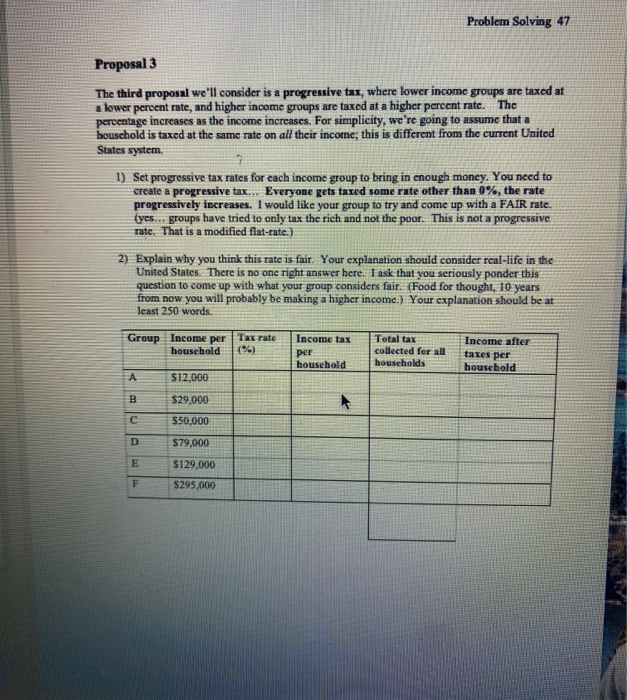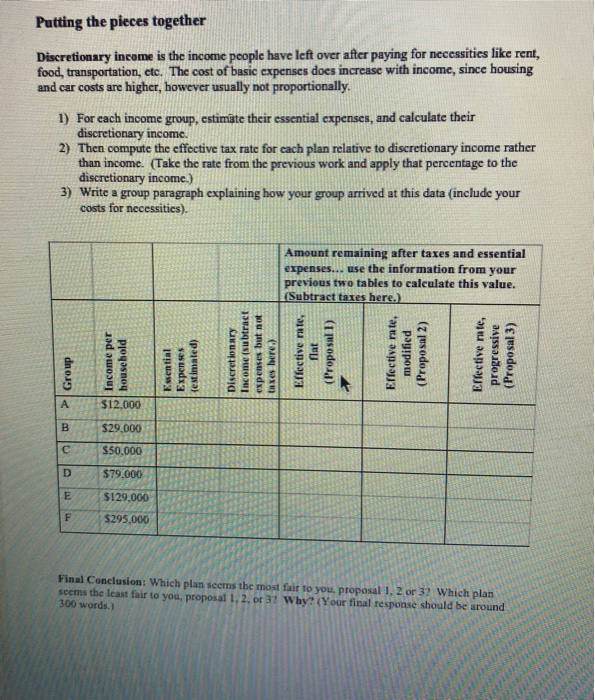Problem Solving 47 Proposal 3 The third proposal we'll consider is a progressive tax, where lower income groups are taxed at a lower percent rate, and higher income groups are taxed at a higher percent rate. The percentage increases as the income increases. For simplicity, we're going to assume that a household is taxed at the same rate on all their income; this is different from the current United States system. 1) Set progressive tax rates for cach income group to bring in enough money. You need to create a progressive tax... Everyone gets taxed some rate other than 0%, the rate progressively increases. I would like your group to try and come up with a FAIR rate. (yes... groups have tried to only tax the rich and not the poor. This is not a progressive rate. That is a modified flat-rate.) 2) Explain why you think this rate is fair. Your explanation should consider real-life in the United States. There is no one right answer here. I ask that you seriously ponder this question to come up with what your group considers fair. (Food for thought, 10 years from now you will probably be making a higher income. Your explanation should be at least 250 words. Group Income per Tax rate household (%) Income tax per household Total tax collected for all households Income after taxes per household A $12.000 B S29,000 550.000 D $79.000 E S129,000 F $295,000 Putting the pieces together Discretionary income is the income people have left over after paying for necessities like rent, food, transportation, etc. The cost of basic expenses does increase with income, since housing and car costs are higher, however usually not proportionally. 1) For each income group, estimate their essential expenses, and calculate their discretionary income. 2) Then compute the effective tax rate for each plan relative to discretionary income rather than income. (Take the rate from the previous work and apply that percentage to the discretionary income.) 3) Write a group paragraph explaining how your group arrived at this data (include your costs for necessities). Amount remaining after taxes and essential expenses... use the information from your previous two tables to calculate this value. (Subtract taxes here.) $12.000 B $29.000 $50.000 D $79.000 E $129.000 F $295.000 Final Conclusion: Which plan seems the most fait to you, proposal 1, 2 or 3? Which plan seems the least fair to you, proposal 1. 2. or 3? Why? (Your final response should be around 300 words.) Problem Solving 47 Proposal 3 The third proposal we'll consider is a progressive tax, where lower income groups are taxed at a lower percent rate, and higher income groups are taxed at a higher percent rate. The percentage increases as the income increases. For simplicity, we're going to assume that a household is taxed at the same rate on all their income; this is different from the current United States system. 1) Set progressive tax rates for cach income group to bring in enough money. You need to create a progressive tax... Everyone gets taxed some rate other than 0%, the rate progressively increases. I would like your group to try and come up with a FAIR rate. (yes... groups have tried to only tax the rich and not the poor. This is not a progressive rate. That is a modified flat-rate.) 2) Explain why you think this rate is fair. Your explanation should consider real-life in the United States. There is no one right answer here. I ask that you seriously ponder this question to come up with what your group considers fair. (Food for thought, 10 years from now you will probably be making a higher income. Your explanation should be at least 250 words. Group Income per Tax rate household (%) Income tax per household Total tax collected for all households Income after taxes per household A $12.000 B S29,000 550.000 D $79.000 E S129,000 F $295,000 Putting the pieces together Discretionary income is the income people have left over after paying for necessities like rent, food, transportation, etc. The cost of basic expenses does increase with income, since housing and car costs are higher, however usually not proportionally. 1) For each income group, estimate their essential expenses, and calculate their discretionary income. 2) Then compute the effective tax rate for each plan relative to discretionary income rather than income. (Take the rate from the previous work and apply that percentage to the discretionary income.) 3) Write a group paragraph explaining how your group arrived at this data (include your costs for necessities). Amount remaining after taxes and essential expenses... use the information from your previous two tables to calculate this value. (Subtract taxes here.) $12.000 B $29.000 $50.000 D $79.000 E $129.000 F $295.000 Final Conclusion: Which plan seems the most fait to you, proposal 1, 2 or 3? Which plan seems the least fair to you, proposal 1. 2. or 3? Why? (Your final response should be around 300 words.)








